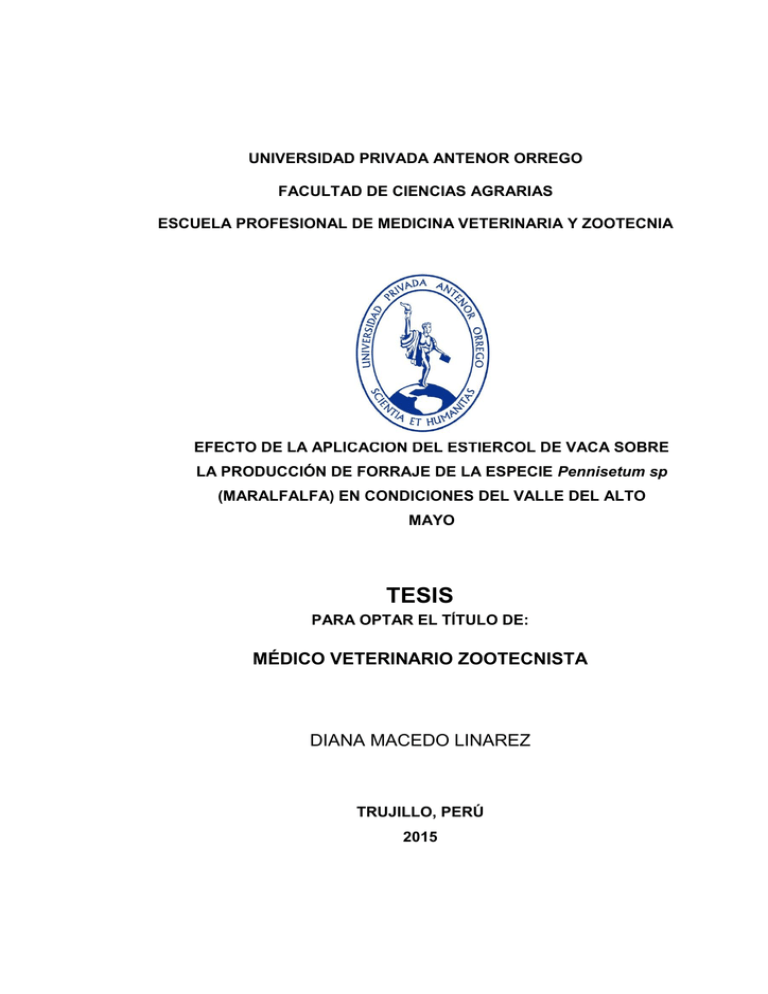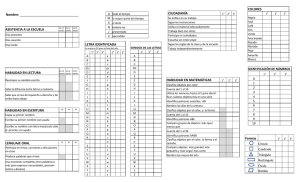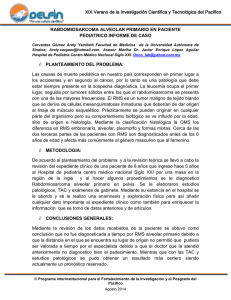MACEDO_DIANA_ESTIERCOL_VACA_MARALFALFA.pdf
Anuncio

i UNIVERSIDAD PRIVADA ANTENOR ORREGO FACULTAD DE CIENCIAS AGRARIAS ESCUELA PROFESIONAL DE MEDICINA VETERINARIA Y ZOOTECNIA EFECTO DE LA APLICACIÓN DEL ESTIÉRCOL DE VACA SOBRE LA PRODUCCIÓN DE FORRAJE DE LA ESPECIE Pennisetum sp (MARALFALFA) EN CONDICIONES DEL VALLE DEL ALTO MAYO TESIS PARA OPTAR EL TÍTULO DE: MÉDICO VETERINARIO ZOOTECNISTA DIANA MACEDO LINAREZ TRUJILLO, PERÚ 2015 ii Med.Vet. Juan Valdivia Pezantes ASESOR RESUMEN Con el objetivo de determinar la productividad del pasto maralfalfa bajo condiciones de abonamiento y riego para el mejoramiento de la ganadería de la zona del Alto Mayo. Se ubicaron al azar 12 parcelas, donde T0: Testigo, T5: Abono Orgánico con Estiércol de Vaca, T10: Abono Orgánico Estiércol de Vaca, T15: Abono Orgánico con Estiércol de Vaca. Cada parcela se dividió en cuatro subparcelas donde se evaluó la composición nutricional y la producción de forraje a los 3 y 6 semanas de rebrote. Se utilizó un diseño en bloques completamente al azar con 4 tratamientos y 3 repeticiones. Se encontraron diferencias significativas (P<0.05) en la composición nutricional cuando el pasto se cortó a diferentes edades. La PB disminuyó con el tiempo alcanzando valores de 12.85% a las 3 semanas, y 4.18% a las 6 semanas. La materia seca aumento logrando su máximo valor a las 3 semanas con 16.09% y su mínimo valor a las 6 semanas con 12.42%. La fertilización y la edad afectaron de una manera significativa (P<0.05) la evaluación agronómica, donde la altura aumento linealmente a medida que aumentaba la edad, obteniendo su máximo valor en el T15 con 1.65m. La producción de materia verde mayor se logró con el T15 con 3865.17t/ha, seguida con el T0 con 3706.67t/ha, en el T10 fue de 3553.67t/ha a las 6 semanas y la mínima producción de materia verde fue en el T0 con 831.32T/ha. La producción de materia seca mayor se logró con el T15 con 526.35t/ha, seguida con el T5 con iii 525.65t/ha, en el T0 fue de 519.84t/ha a las 6 semanas y la mínima producción de MV fue en el T5 con 133.79t/ha. ABSTRACT With the aim of determining the productivity of maralfalfa grass under conditions of crediting and irrigation for the improvement of animal husbandry in the area of the Alto Mayo. Were placed at random 12 plots, where T0: Witness, T5: Organic Fertilizer with cow dung, T10: manure cow dung, T15: Organic Fertilizer with cow dung. Each plot was divided into four subplots where was evaluated the nutritional composition and forage production at 3 and 6 weeks of regrowth. A design was used in a randomized complete block with 4 treatments and 3 repetitions. Significant differences were found (P<0.05) in the nutritional composition when the grass is short at different ages. The PB decreased with the time reaching values of 12.85% at 3 weeks, and 4.18% at 6 weeks. The MS increase by achieving your maximum value at 3 weeks with 16.09% and your minimum value at 6 weeks with 12.42%. The fertilization and the age affected of a significant way (P<0.05) the agronomic evaluation, where the height increase lineal as increasing the age, by obtaining your maximum value in the T15 with 1.65m. The production of MV major it is achieved with the T15 with 3865.17t/ha, continued with the T0 with 3706.67t/ha, succession with the T0 with 3706.67t/ha, in the T10 went of 3553.67t/ha at 6 weeks iv and the minimum production of MV concerned the T0 with 831.32t/ha. The production of MS major it is achieved with the T15 with 526.35t/ha, succession with the T5 with 525.65t/ha, in the T0 went of 519.84t/ha at 6 weeks and the minimum MV production concerned the T5 with 133.79t/ha. NOTA: Tesis no autorizada de publicación, para obtener más detalle de la tesis, acercarse a Sala de Tesis de la Biblioteca Central de la Universidad Privada Antenor Orrego, de la Ciudad de Trujillo. 5

